鲁教版七上Unit6《Howdoyougettoschool》word重难点解析
- 格式:doc
- 大小:81.50 KB
- 文档页数:2
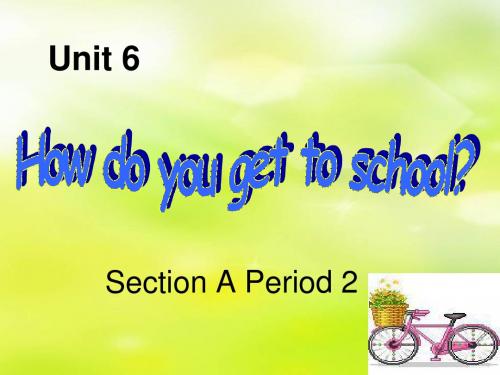
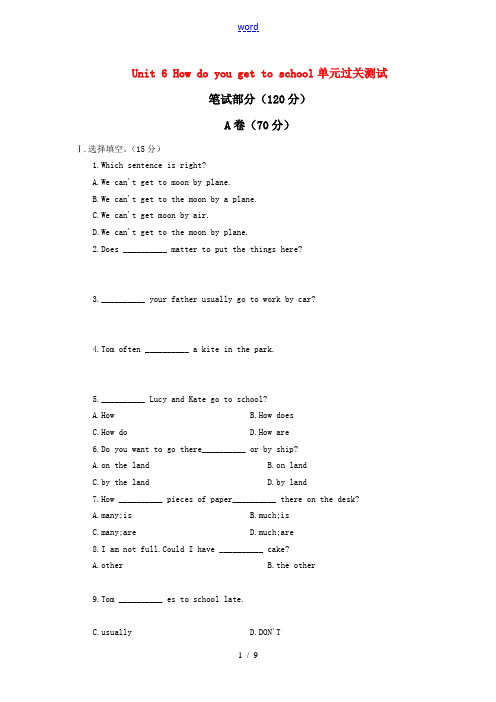
Unit 6 How do you get to school单元过关测试笔试部分(120分)A卷(70分)Ⅰ.选择填空。
(15分)1.Which sentence is right?A.We can't get to moon by plane.B.We can't get to the moon by a plane.C.We can't get moon by air.D.We can't get to the moon by plane.2.Does __________ matter to put the things here?3.__________ your father usually go to work by car?4.Tom often __________ a kite in the park.5.__________ Lucy and Kate go to school?A.HowB.How doesC.How doD.How are6.Do you want to go there__________ or by ship?A.on the landB.on landC.by the landD.by land7.How __________ pieces of paper__________ there on the desk?A.many;isB.much;isC.many;areD.much;are8.I am not full.Could I have __________ cake?A.otherB.the other9.Tom __________ es to school late.uallyD.DON'T10.How many __________ can you see in the park?I can see__________.A.peoples;eightB.peoples;eigC.people;eightD.people;eig11.What can you see in __________ picture on the wall?I can see __________ bird.A.a;aB.the;/C.the;aD.a;the12.__________ is nice and clean.A.The air of todayB.Today airC.Today's airD.The air today13.__________ boy under the tree is an American.A.TheB.×14.How many books __________ there in your school library?15.__________ can you get there on time?By car.Ⅱ.选出与划线部分意思相近的选项。
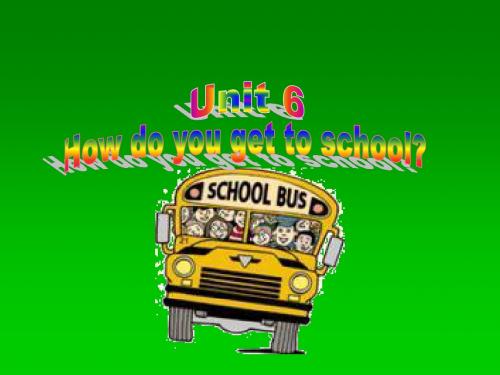
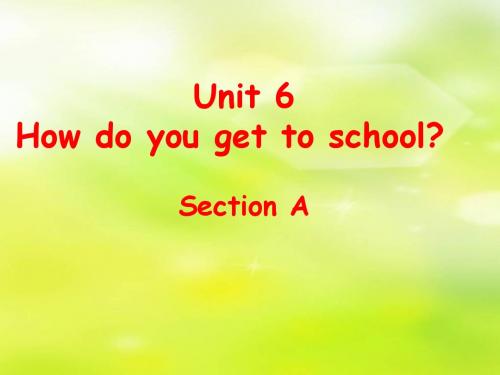

Unit 3 H d u get t shl? 第二时教案分析Unit3Hdugettshl?第二时教案分析SetinA2a-GraarFus一、教学目标:1语言知识目标:1)继续练习谈论出行方式taethebus/suba/train/taxi,rideabie/al2)用不同方式练习h引导的特殊疑问句,表示乘坐何种交通工具的方式。
hfar,hlng引导的特殊疑问句。
3)温习基数词及时刻的表示方式。
2情感态度价值观目标:了解东西方国家出行方式的不同,和不同的交通规那么,教育学生注意交通平安,加深对交通知识的了解。
提倡自觉遵守交通法规及礼貌,构建和谐的人际关系。
了解交通的进展,培育创新精神。
二、教学重难点1教学重点:1)h/hfar/hlng引导的特殊疑问句2)乘坐交通工具的表示方式3)Ittaessbsetietdsth2教学难点:—Hdugettshl?—Itaethe…/ride…/al…—Hdesargettshl?—Shetaesthesuba—Hlngdesittae?—Ittaesfrtinutes—Hfarisitfr…t…—It's…ileters三、教学进程(一)aring-upandrevisin1GreettheSsasusualThenhetheher2Gverthenversatinin2e(二)Presentatin18fift03nehundredandthree900ninehundredHlng?Tent-fiveinutesHfar?Tenil-eters2从一个地址到另一个地址花多长时刻利用句型:Hlngdesittae?3Asandanser:Hlngdesittaeutshl?Ittaeseinutestshl4快速抢答:HlngdesittaeZhuBihangtgetttheinea?PairrHlngdesittaehe/shetgettshlnft/bbus/bbie?IttaesHfarisitfrt?ItisiletersListening11a:Listentthetapeandrepeatthenubers2Listentthetapeandfinish2bPairrStudentAisaneandStudentBisTHdugettshl?Hlngdesittae…?Hfarisitfr…t…?1Readthenversatinandanserthequestins2Listentthetapeandrle-plathenversatin3RetellthenversatinandfillintheblansLisa:He,aneIsthisurne________?ane:es_____________everdaHdugettshl?Lisa:Iusuall__________ane:_______isitfrurhetshl?Lisa:I’ntsure…abut10ileters?________taesabut20inutes__________desitt aeutgettshl?ane:Abut1inutes____bieIt’sgdexeriseLisa:eahell,_____________atshlane:u,tGraarFus1Explaintheharttstudentsandstudentsreadthesentenes tgether23a:aththequestinsiththeansersThenpratiethe3Studentsfinish3bAsurveAsurlassatesquestinsandritetheirnaesinthehartThefirst studenttfillinalltheblansins!Findseneh…Naelivesabutfiveiletersfrshlalstshltaesabustshl gestshlbbie needsabutanhurtgettshl needsabut10inutestgettshl Her1pthesentenesinGraarFus 2Reitethenversatinin2e。
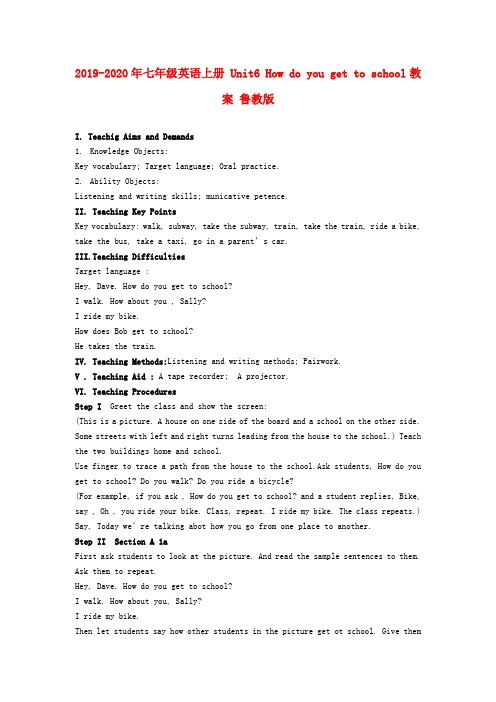
2019-2020年七年级英语上册 Unit6 How do you get to school教案鲁教版I. Teachig Aims and Demands1.Knowledge Objects:Key vocabulary; Target language; Oral practice.2.Ability Objects:Listening and writing skills; municative petence.II. Teaching Key PointsKey vocabulary: walk, subway, take the subway, train, take the train, ride a bike, take the bus, take a taxi, go in a parent’s car.III.Teaching DifficultiesTarget language :Hey, Dave. How do you get to school?I walk. How about you , Sally?I ride my bike.How does Bob get to school?He takes the train.IV. Teaching Methods:Listening and writing methods; Pairwork.V . Teaching Aid : A tape recorder; A projector.VI. Teaching ProceduresStep I Greet the class and show the screen:(This is a picture. A house on one side of the board and a school on the other side. Some streets with left and right turns leading from the house to the school.) Teach the two buildings home and school.Use finger to trace a path from the house to the school.Ask students, How do you get to school? Do you walk? Do you ride a bicycle?(For example, if you ask , How do you get to school? and a student replies, Bike, say , Oh , you ride your bike. Class, repeat. I ride my bike. The class repeats.) Say, Today we’re talking abot how you go from one place to another.Step II Section A 1aFirst ask students to look at the picture. And read the sample sentences to them. Ask them to repeat.Hey, Dave. How do you get to school?I walk. How about you, Sally?I ride my bike.Then let students say how other students in the picture get ot school. Give themsome help if necessary. For example, take the bus ; take the train; take the subway. Read the phrases to them and ask them to repeat. Then ask them to write them in the box and add other ways to get to school.Then check the answers.Step IV 1bFirst point out the names of the students in the box. Ask one student to read the names. Now listen to the conversation. Please write the number of the name in the white box next to the student. One of them has already been done.Then ask students to say what each person is doing.Write the phrases on the board: walking, taking the train, taking the subway, taking the bus.Check the answers on the screen. Then ask the students how Bob /Mary /Paul /Yang Lan /John gets to school?Then, use these persons to make a dialogue like this:A: Hey, Bob. How do you get to school?B: I take the train. How about you, Mary?A: I take the subway.Ask students to plete the activity individually.Then check the answersStep V 1c PairworkAsk two students to read the dialogue in the box to the class.A: How does Bob get to school?B: He takes the train.Now work with a partner. Make your own conversations about how the people in the picture get to school.Then ask students to work in pairs. Ask and answer how students get to school in the picture..(Present their conversations to the class.)As they talk , move around the room, offering language or pronunciation support as needed.Step VI Summary and HomeworkThis class we’ve learnt some key vocabulary and the target language . How do you (does he )get to school? Next class I’ll ask some students to tell me the answers. Step VII Blackboard DesignUnit 4 How do you get to school?walk subway traintake the subway/train go in a parent’s carHow do you get to school? I walk.How does he get to schllo? He walks.Step VIII Teaching reflection:2019-2020年七年级英语上册 unit6 教案人教新目标版一、教学背景分析(一)教学内容分析本单元的中心话题是Food,主要语言功能项目是Talk about likes and dislikes,语法结构为Present tense to like, Yes / No questions and short answers, Affirmative and negative statements。
鲁教版英语七上Unit 6 How often do you eercise Period2 说课稿一. 教材分析鲁教版英语七上Unit 6 How often do you exercise是一篇以谈论运动频率为主题的文章。
文章通过介绍不同人的运动习惯,引导学生学会如何询问别人的运动频率以及如何表达自己的运动习惯。
本课内容贴近学生生活,有助于激发学生的学习兴趣。
二. 学情分析七年级的学生已经掌握了基本的英语语法和词汇,具备一定的听说读写能力。
但部分学生对英语口语表达仍存在恐惧心理,不敢开口说英语。
此外,学生对运动话题有一定的兴趣,但可能对如何用英语表达运动习惯还不够了解。
三. 说教学目标1.知识目标:学生能够掌握表示频率的词汇如often, sometimes, rarely等;能够用英语询问并回答别人的运动习惯。
2.能力目标:学生能够用英语进行简单的日常交流,提高口语表达能力。
3.情感目标:培养学生热爱运动,养成良好的运动习惯。
四. 说教学重难点1.重点:学生能够用英语询问并回答别人的运动习惯。
2.难点:学生能够用英语表达自己的运动习惯,并正确使用表示频率的词汇。
五. 说教学方法与手段1.任务型教学法:通过设置不同的任务,让学生在实践中学会用英语表达运动习惯。
2.情境教学法:创设真实的情境,让学生在实际语境中学习英语。
3.合作学习法:引导学生分组讨论,培养学生的团队协作能力。
六. 说教学过程1.导入:以一段关于运动的视频导入,激发学生的兴趣。
2.新课呈现:教师展示教材图片,引导学生观察并说出运动者的运动习惯。
3.讲解与练习:教师讲解表示频率的词汇,并通过示例让学生练习。
4.小组讨论:学生分组讨论自己的运动习惯,并用英语表达。
5.口语输出:学生模拟情境,向同学询问运动习惯,并用英语回答。
6.课堂小结:教师总结本节课所学内容,强调重点。
七. 说板书设计板书设计如下:How often do you exercise?•Often•Sometimes•Rarely八. 说教学评价1.课堂表现评价:观察学生在课堂上的参与程度、口语表达能力和团队协作能力。
Unit6 Period5 精品教案Teaching objectives:After the lesion, students will be able to1. finish the tasks on the textbook by using what they learnt2. practice the grammar points by doing the tasksImportant points and difficult points:1. review the grammar points2. use the grammar points to finish the tasks导入语:Good morning, class! How are you today? Did you have a good sleep last night? Don’t be too tired because we should have a healthy lifestyle. Let’s go on learning Unit 1. This is the last period.Step 1: Revision:1.First, let’s write down 3a from memory.2.Please hand in your paper. Quickly!Step 2: Self-check-1Fill in the blanks. Please finish 1 as quickly as you can.Check the answers.Explain the difficulties and underline the phrases.Look at these sentences and underline some phrases.Make sentences with the words given.Can you make your own sentences with the words? Have a try.Step 3: Self-check-21.Divide into groups.The whole class should be divided into 8 groups. There are about six students in each group.2.Discuss.Have a discussion with your classmates and choose a famous person to talk about. Imagine what his or her lifestyle is like and then fill in the blank.3Everyone writes a report according to the chart you filled in.4.Read the report. Then read your report in your group. Select the best report in your group. Each group reads the best report in front of the class, and I will give you a mark. The full mark is 5 points.5Step 4: Exercisea. Watch the PPT and let’s do some exercises.b. Let’s check the answers.Step 5: Summarya. Let’s summarize what we learnt in this period.b. Yes. We learnt how to investigate others’ lifestyle and know how to write a report about it.Step 6: Homework1.Finish Unit 1 in the workbook;2.Finish Test A and Test B in the test package.。
Unit 6 重难点解析
1、How does Bob get to school?鲍勃怎样上学?
(1)询问去某地的交通方式,用how提问。
How作疑问副词,还可以表示“如何怎样,以何种方式或手段。
”例如:How should I do?我该怎么做?
(2)get表示“到达……”,是不及物动词,若加宾语,后需跟介词to。
例如:When can you get t o school?你何时能够到达学校?When will he get to Shanghai?他什么时候将到达上海?如果get后接的是副词,就不需要加to。
例如:I usually get home at 7:00.我通常7点到家。
I will get there on time.我会按时到那里的。
2、He takes the train.他坐火车。
(1)“take + the + 交通工具”用于表示“乘坐……”,相当于“by + 交通工具”。
例如:It will save you a lot of time if you take the subway to go there.如果你乘坐地铁去那里,可以省很多时间。
(2)与交通方式有关的动词短语有:take the subway 乘地铁 take the bus 乘公共汽车take the train 坐火车take a taxi 乘出租车drive a car 开小车 ride a bike 骑自行车等。
(3)表示交通方式的介词有:by, in, on。
by表示运用某种交通工具、手段,其后必须接交通工具的单数形式,并且工具前无冠词。
例如:by bus 乘公共汽车 by plane 乘飞机 by ship 坐轮船by boat 乘船 by train 坐火车 by taxi 乘出租车by bike骑自行车。
In/on 表示乘坐某种交通工具,其后接冠词或物主代词,再接交通工具名词。
注意:on通常指乘坐大型交通工具或步行、骑自行车。
In通常指乘坐小型的交通工具。
例如: on foot 步行on a bike 骑自行车 in a car 坐小汽车等。
提示:表示交通方式的动词短语可以用介词短语替换。
例如:
I usually ride a bike to school.=I usually go to school o n a bike/by bike.我通常骑自行车去上学。
She walks to work every day.=She goes to work on foot eve ry day.她每天步行去上班。
3、—How long does it take?
(步行,乘车)要花多长时间?
—It takes about 25 minutes to walk and 10 minutes by bus.
步行需要大约25分钟,乘车需要10分钟。
在固定句型It takes sb. some time to do sth.中,take表示“花费”的意思,因而该句型的意思是“花费某人多长时间做某事”。
It是形式主语,不定式to do是真正的主语,如果我们对宾语提问时,就用how long(多久)引导一个特殊疑问句。
例如:
—How long does it take you to go to school on foot?你步行上学需要多长时间?
—It takes about 15 minutes.大约15分钟。
It took me too much time to solve this problem.解这道题花了我太多时间。
4、—How far is it from your home to school?从你家到学校有多远?
—It’s three miles. 三英里。
(1)本句中it指代的是距离。
例如:
It’s about a few kilometers away.大约有几千米远。
(2)how far“多远”,用于询问两地间的距离,答语常用It’s …meters/kilometers/miles/句型或直接用表示距离的词语。
例如:
—How far is it from Beijing to Shanghai ?从北京到上海有多远?
—It’s about several thousand kilometers.大约有几千千米。
—How far does your uncle live from here?你叔叔住的地方离这有多远?
—About ten minutes’ walk.大约步行10分钟。
提示:在回答How far的提问时,有两种情形:
①有具体数字时,应与away from连用,表示距离的计量。
口语中away可省去。
②没有具体数字时,应用far或near作答。
例如:
—How far away is the moon from the earth?月亮距离地球有多远?
—It’s 380,000 kilometres away from the earth.从地球到月球有380,000千米。
—It’s very far.那很远。
(3)from…to…从……到……该短语后可以接地点名词、地点副词或表示时间的词及其它词语。
例如:
Please do exercises from 5 to 9. 请做练习从5题到9题。
Spring is from January to March. 春季是从1月到3月。
提示:有关from…to…的短语:from house to house 挨家挨户 from head to foot 从头到脚
from beginning to end 从头到尾 from time to time 有时,偶尔 from hand to hand 一手转一手
5、That must be a lot more fun than taking a bus.那一定比乘公共汽车有意思多了。
(1)must在本句中表示推测,意思是“一定是,必然”。
例如:
It’s already ten o’clock. My mother must be angry. 已经十点钟了,我妈妈准生气了。
(2)fun:不可数n.意为“玩笑、乐趣”,其前即使有形容词修饰也不加a(an)。
have fun doing sth.意为“做某事有乐趣”.例如:
We have fun learning and speakin g English. 我们学说英语很有乐趣。
(3)a lot 可修饰比较级,表示“……很多,”相当于much。
(4)that指go to school by boat这件事。
山东淄博沂源燕崖中学齐永华。